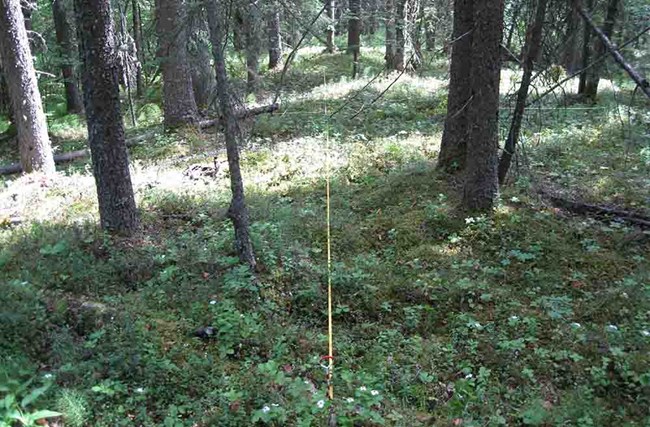Last updated: May 6, 2021
Article
Competition and dry site conditions amplify white spruce climate sensitivity

The boreal forest represents nearly a third of all the forest in the world and contains 22% of all the stored carbon on the Earth’s land surface. The northern latitudes that the boreal forest occupies are experiencing some of the most pronounced climate warming on the planet, but the exact effects that warming has on the forest are not totally understood.
It has been documented that both warmer summers and high competition with nearby trees can reduce growth in the boreal forest, but the interactive effects of competition and climate warming on tree growth are not well studied. This 2018 paper in the journal Global Change Biology investigates the relationship between those two factors, revealing that areas of more productive forests are more susceptible to the challenges of a warming climate.

The researchers used tree cores – slivers of wood extracted from the trunk that show growth rings without hurting the tree – from 357 white spruce trees located across a large sampling grid in Denali National Park and Preserve. Some of the trees grew on steep, sparse hillslopes while others were in dense lowland basins, and the researchers used a suite of environmental data collected from the same grid to control for other variables.
With the tree cores, they could measure the distance between growth rings to see how much wood a tree added to its trunk every year. They also analyzed the samples for carbon-13, which offered insight into how drought-stressed a tree was in each year of its life.
The researchers found that while warmer, drier summers tended to reduce tree growth overall, this effect was greatly amplified in areas with many large, closely packed trees and in dry areas. In places where more trees were competing for fewer resources, it seemed, the forest was extra sensitive to small changes in climate.
The study also found several other interactions between environmental variables, reinforcing the complexity of forest ecology – factors like tree age have a large influence on growth rates, and those factors often have much stronger effects than changes in climate. But overall, the study supports the idea that dense, “fully stocked” boreal forests may become sparser in a warmer, drier future.
Stand basal area and solar radiation amplify white spruce climate sensitivity in interior Alaska: Evidence from carbon isotopes and tree rings
Abstract
The negative growth response of North American boreal forest trees to warm summers is well documented and the constraint of competition on tree growth widely reported, but the potential interaction between climate and competition in the boreal forest is not well studied. Because competition may amplify or mute tree climate‐growth responses, understanding the role current forest structure plays in tree growth responses to climate is critical in assessing and managing future forest productivity in a warming climate. Using white spruce tree ring and carbon isotope data from a long‐term vegetation monitoring program in Denali National Park and Preserve, we investigated the hypotheses that (a) competition and site moisture characteristics mediate white spruce radial growth response to climate and (b) moisture limitation is the mechanism for reduced growth. We further examined the impact of large reproductive events (mast years) on white spruce radial growth and stomatal regulation. We found that competition and site moisture characteristics mediated white spruce climate‐growth response. The negative radial growth response to warm and dry early‐ to mid‐summer and dry late summer conditions intensified in high competition stands and in areas receiving high potential solar radiation. Discrimination against 13C was reduced in warm, dry summers and further diminished on south‐facing hillslopes and in high competition stands, but was unaffected by climate in open floodplain stands, supporting the hypothesis that competition for moisture limits growth. Finally, during mast years, we found a shift in current year's carbon resources from radial growth to reproduction, reduced 13C discrimination, and increased intrinsic water‐use efficiency. Our findings highlight the importance of temporally variable and confounded factors, such as forest structure and climate, on the observed climate‐growth response of white spruce. Thus, white spruce growth trends and productivity in a warming climate will likely depend on landscape position and current forest structure.
Nicklen, E. F., C. A. Roland, A. Z. Csank, M. Wilmking, R. W. Ruess, and L. A. Muldoon. 2018. Stand basal area and solar radiation amplify white spruce climate sensitivity in interior Alaska: Evidence from carbon isotopes and tree rings. Global Change Biology 25(3): 911-926.
